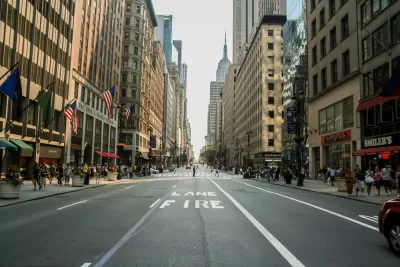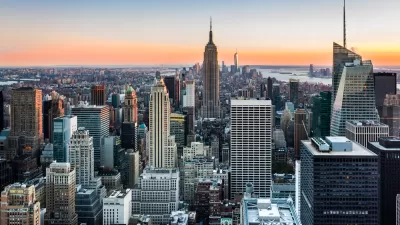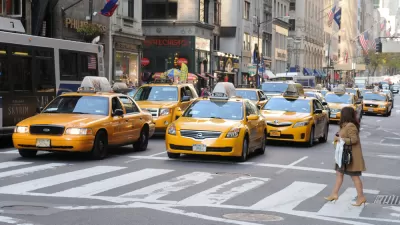Finally, congestion pricing, as applied to city cordons, not highways, will be coming to the U.S., thanks to a budget deal approved by the New York State Legislature early Sunday morning. Tolls below 60th Street should begin by Jan. 1, 2021.

"State politicians announced an agreement shortly after midnight on Sunday to approve the tolling policy for Manhattan as part of a broader package of funding and reforms to the Metropolitan Transportation Authority stuffed into the state’s $175 billion budget," writes Vincent Barone, transit reporter for amNewYork on April 1, the deadline to pass the state budget.
The key details of the plan — including the price of the tolls — will be worked out on a future date.
Under the agreement, tolls would be activated by the end of 2020 and charge drivers as they pass 60th Street in Manhattan. The FDR Drive and West Side Highway would be excluded. Car owners living within the tolled district who make less than $60,000 a year would also be eligible for credits, according to the budget. Drivers wouldn't be tolled more than once per day.
"The agreement makes New York City the first city in the nation to implement a congestion pricing plan, which the state has dubbed the Central Business District Tolling Program," writes Rebecca C. Lewis for City & State NY on April 1.
Widely called "congestion pricing," now common on many express lanes on highways, rather than the more precise "cordon area congestion pricing," Barone reports that it is uncertain if the toll would be variable, i.e., higher for peak-hours, and reduced when traffic is light, which is what is generally associated with congestion or value pricing. However, note that the Federal Highway Administration defines "cordon charges," which is what the legislature authorized, as "either variable or fixed charges."
Tolling infrastructure
"The authority is looking to 'minimize the infrastructure footprint, and leverage current infrastructure, to the greatest extent possible,'" reports Barone in a separate piece on the agreement on April 1. Overhead toll gantries that read E-ZPass transponders are not a certainty.
The MTA is already exploring the use of new roadside readers to tap into cars’ Bluetooth systems, as well as the possibility of utilizing drivers’ smartphone GPS systems without the need for any new street infrastructure, among a handful of other options to charge drivers entering the congestion zone, according to request for ideas that Bridges and Tunnels issued last Thursday.
Who will work out "the details?"
That would be the six-member Traffic Mobility Review Board, which "will next year recommend toll pricing, which could vary based on the time of day, as well as other exemptions and potential credits for drivers to the MTA's Triborough Bridge and Tunnel Authority [TBTA], which will oversee the program and give the state significant say over city traffic," adds Barone. "The plan is expected to raise $1 billion a year, which the MTA could bond against for up to $15 billion."
Members of the board will be appointed by the TBTA. "New York City Mayor Bill de Blasio will recommend one, one will come from the 'Long Island Rail Road Region' and one will come from the 'Metro North Region," adds Lewis.
Congestion pricing politics
Having the state's two commuter railroads receive some of the revenue was key to the budget agreement, reported Winnie Hu for The New York Times on March 28. "Long Island lawmakers want revenue from congestion pricing to flow to the commuter trains their constituents ride."
“At the end of the day, congestion pricing for Long Islanders should mean a better Long Island Rail Road,” said Senator Todd Kaminsky, who leads an influential six-member Long Island delegation that is part of the Senate’s Democratic majority.
Hu delves into the disproportionate subsidies received by the LIRR, not only in comparison to the New York City Transit Authority, but also Metro-North Railroad.
Finally, Jesse McKinley and Vivian Wang of The New York Times observed on March 31 that the budget deal negotiations took "weeks of intraparty bickering," which would include the aforementioned LIRR funding battle, unlike other state transportation funding legislation, e.g., last month's Alabama 10-cents per gallon fuel tax increase that was marked by bipartisan cooperation.
"Republicans mostly oppose the concept, referring to it as a new tax," reports Katie Pyzyk of Smart Cities Dive. As noted in a post on the politics underlying the collapse of the Amazon deal in Queens in February, the midterm elections brought major changes to the legislature.
Readers may wish to listen to a report from NPR-affiliate, WNYC, on the approval of the congestion pricing program by the legislature, as well as other aspects of the budget legislation, e.g., plastic bag ban, and/or read Gov. Andrew Cuomo's statement on the 2020 budget agreement: "We Got it Done!"
Related in Planetizen:
-
Congestion Pricing Plan Dies in New York Assembly, April 8, 2008
FULL STORY: Congestion pricing passes, but without key details

Study: Maui’s Plan to Convert Vacation Rentals to Long-Term Housing Could Cause Nearly $1 Billion Economic Loss
The plan would reduce visitor accommodation by 25,% resulting in 1,900 jobs lost.

Alabama: Trump Terminates Settlements for Black Communities Harmed By Raw Sewage
Trump deemed the landmark civil rights agreement “illegal DEI and environmental justice policy.”

North Texas Transit Leaders Tout Benefits of TOD for Growing Region
At a summit focused on transit-oriented development, policymakers discussed how North Texas’ expanded light rail system can serve as a tool for economic growth.

Paris Bike Boom Leads to Steep Drop in Air Pollution
The French city’s air quality has improved dramatically in the past 20 years, coinciding with a growth in cycling.

Why Housing Costs More to Build in California Than in Texas
Hard costs like labor and materials combined with ‘soft’ costs such as permitting make building in the San Francisco Bay Area almost three times as costly as in Texas cities.

San Diego County Sees a Rise in Urban Coyotes
San Diego County experiences a rise in urban coyotes, as sightings become prevalent throughout its urban neighbourhoods and surrounding areas.
Urban Design for Planners 1: Software Tools
This six-course series explores essential urban design concepts using open source software and equips planners with the tools they need to participate fully in the urban design process.
Planning for Universal Design
Learn the tools for implementing Universal Design in planning regulations.
Smith Gee Studio
Alamo Area Metropolitan Planning Organization
City of Santa Clarita
Institute for Housing and Urban Development Studies (IHS)
City of Grandview
Harvard GSD Executive Education
Toledo-Lucas County Plan Commissions
Salt Lake City
NYU Wagner Graduate School of Public Service





























